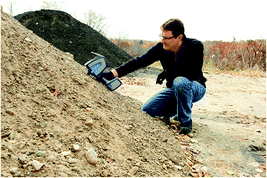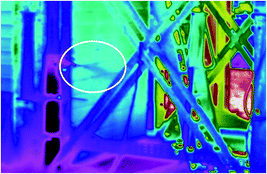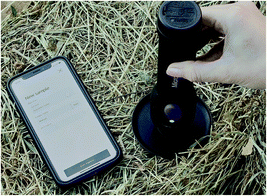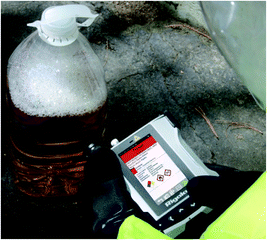An introduction to hand-held infra-red and Raman instrumentation
Analytical Methods Committee, AMCTB No. 94
First published on 9th March 2020
Abstract
The past 20 years have seen widening applications of hand-held instruments which facilitate operation outside the confines of a laboratory thereby enabling on-site and in situ analysis of test materials with limited or no test material preparation. Hand-held infra-red and Raman instrumentation is now available for a wide range of applications in fields such as manufacturing, environmental protection or security, enabling staff without chemical analysis training to provide rapid answers to specific questions. This Technical Brief aims to inform both analysts and less-technically aware users of the applications, capabilities and limitations associated with the use of this equipment.
Introduction
There are several types of hand-held infra-red (IR) and Raman instrumentation intended for on-site measurements.
IR spectroscopy depends on molecules absorbing radiation at IR wavelengths due to the vibration of chemical bonds at frequencies which vary between chemicals. Test materials are analysed using transmittance, where the IR beam is passed through the test material, or reflectance, where the beam is reflected off the surface of the test material. Conventional IR spectra are measured across a spectral range of 400–4000 cm−1, widely termed the mid-IR. Most instrumentation in this range is based on the Fourier transform method and the technique is generally referred to as FTIR spectroscopy. A broadband radiation source is processed by an interferometer, creating an energy interference pattern that is absorbed or transmitted by the test material. The detected radiation is Fourier transformed, generating an IR spectrum. Recent years have seen increasing use of the near IR (NIR) region between 4000 and 12![[thin space (1/6-em)]](https://www.rsc.org/images/entities/char_2009.gif) 500 cm−1. NIR spectroscopy is less sensitive than FTIR, both in terms of the amount of substance that can be detected and the differences between the spectral characteristics of different molecules. However, it is widely used in relatively small and cheap portable instruments targeting specific application areas.
500 cm−1. NIR spectroscopy is less sensitive than FTIR, both in terms of the amount of substance that can be detected and the differences between the spectral characteristics of different molecules. However, it is widely used in relatively small and cheap portable instruments targeting specific application areas.
Raman spectroscopy uses scattered light, typically from a laser, to identify molecules present in a test material from their vibrational frequencies. As with IR spectroscopy, these are specific to the chemical bonds present and their arrangement within the molecule. However, the instrumentation is more challenging because most incident photons undergo elastic Raleigh scattering from the test material. Only a tiny proportion (typically around 0.001%) interact with the molecules in the test material to produce an inelastic, frequency-shifted Raman signal. As this signal is very weak, numerous approaches to enhance it and/or distinguish it from interfering radiation (e.g., fluorescence) have been incorporated into instruments.
Hand-held instruments using the techniques described above are widely used for qualitative analysis, the identification of unknowns, by looking at the IR or Raman spectrum as a whole. They can also be used for quantitative analysis. For FTIR and NIR this requires measurement of absorbance of the IR beam at one or more characteristic wavelengths. In the case of Raman, quantitation requires measuring the intensity of the Raman scattering signal at a characteristic frequency. However, this requires preparation of a calibration curve for the specific material and instrument using identical excitation and experimental conditions.
The primary use of these devices is on-site analysis without the delay caused by having to transport test materials back to a laboratory. This allows investigators to undertake assessment of problems within a single visit facilitating on-site decision making. Most, but not all, measurements are non-destructive thereby offering opportunities for further investigation by other techniques.
Hand-held FTIR spectrometers
Hand-held FTIR spectrometers (see Fig. 1) are primarily intended for in situ measurements in applications such as quality control, material identification, authentication and surface contamination. Other applications include non-destructive testing of polymers, coatings, food, art objects, explosives, industrial chemicals and minerals. | ||
| Fig. 1 Hand-held FTIR (©Agilent Technologies, Inc. Reproduced with permission, courtesy of Agilent Technologies, Inc.). | ||
These devices are generally battery powered, with size and weight (typically around 3 kg) being reduced using ultra-compact interferometers and lithium-ion batteries. The latest instruments incorporate touch screen controls enabling use by operators with lower levels of experience than traditional instruments. For example, production workers or members of the emergency services. Some instruments can be coupled to ‘plug in’ test material interfaces which mimic the accessories used on bench-top instruments. However, they have less versatility or data manipulation capability than laboratory devices. They also have limited access to facilities such as spectral libraries for identification of unknown materials.
FTIR gas analysers
FTIR gas analysers are typically battery powered, weigh around 10 kg and are intended for analysis of airborne gases and vapours. The main limitation is that the gas being measured must absorb in the IR. This precludes diatomic gases such as oxygen, nitrogen and chlorine or inert monatomic gases such as helium and argon.The latest generation of gas analysers can detect up to 25 gases simultaneously providing results in as little as 25 seconds. The library of measured gases can be changed by the user to enable measurement of other gases. Operating times are typically around 2–3 hours. Applications include:
• Occupational health measurement in areas such as hospitals (anesthetics), painting (volatile organic compounds), dry cleaning (halocarbons), shipping containers (various) and fumigation (various);
• Leak detection;
• Emergency first responders (fire and other emergency services);
• Chemical warfare agent detection.
A recent development of IR gas analysers is the IR gas imaging camera. These have lower sensitivity than FTIR gas analysers but can, for example, provide visual assessment of gas leaks from pipework, tanks and other sources at a safe distance (see Fig. 2). Such devices typically weigh below 2 kg and are sufficiently small to mount on drones or other unmanned aerial vehicles (UAVs). These facilitate remote aerial investigation of otherwise inaccessible and potentially hazardous sites.
 | ||
| Fig. 2 Detection of gas leak, in this case methane from a cylinder, using an IR camera (image reproduced with the permission of the Health and Safety Executive, HSE). | ||
NIR analysers
NIR instrumentation is simpler than FTIR and more amenable to construction of hand-held instruments. Nevertheless, development has lagged behind FTIR with the first commercial equipment only appearing around 2005, reflecting the inherent analytical limitations of NIR compared with FTIR spectroscopy.The absorption bands observed in the NIR (mostly from O–H, C–H, and N–H bonds) are very broad compared with those in the mid-IR. These bands are common to many organic molecules so NIR spectra of different compounds often show only minor differences, leading to poor molecular selectivity. NIR is also less sensitive than FTIR, precluding analysis of components in mixtures below a few percent. The physical nature of the test material also has a significant effect on NIR spectra. This is due to the diffuse reflectance technique used in most instruments which allows radiation from the NIR source to pass through gaps between particles. The amount escaping varies with characteristics such as particle size, packing density, porosity or the presence of air bubbles, shifting the baseline of the NIR absorption spectra by differing amounts. These factors have both advantages and disadvantages for developing simple hand-held instruments.
A typical small NIR device uses one or more tungsten lamps as the illumination source, a linear variable filter dispersing element, and a photodiode array detector. Bulk solid materials are easily sampled using diffuse reflectance whilst holding the instrument window a few mm from the test material. This approach allows measurements without contact with the test material, typically with a penetration depth between 200 and 500 microns. The weak nature of the NIR signal is an advantage for examining large volumes of bulk materials without limiting the test material surface as with optical spectroscopy. Devices using fibre-optic probes facilitate sampling of discrete areas or may be pushed through packaging, allowing direct measurement of the material within. The sensitivity of NIR to physical characteristics of the material means that, unlike FTIR or Raman, it can be used to classify chemically identical materials, such as flour or pharmaceuticals, according to properties such as particle size. For these reasons NIR is used in a wide range of hand-held devices.
Due to the poor molecular selectivity, NIR instruments must be calibrated or ‘trained’ for specific applications. For example, qualitative applications require a set of test materials of known identity or composition to be analysed then classified using chemometric techniques according to specific characteristics. Unknown test materials with characteristics in the range of the training set can then be identified by the instrument software. The same principles allow calibration of instruments for quantitative analysis using a set of test materials for which the concentration of one or more constituents is known. Acquiring and validating such data is laborious so manufacturers usually undertake this work themselves, marketing instruments for specific applications. These include quality control of foodstuffs, pharmaceuticals and raw materials, bulk assessment of minerals and agricultural materials, identification of polymers and chemicals, environmental studies, safety testing of cosmetics and detection of narcotics and explosives. Recent advances in microelectronics allow incorporation of demanding data processing and storage capabilities into small, relatively cheap portable devices (see Fig. 3).
 | ||
| Fig. 3 Analysis of foodstuffs using a hand-held NIR analyser (image reproduced with the permission of SciMed). | ||
Raman analysers
Hand-held Raman analysers similar in operation to IR devices are also designed for specific tasks. Applications include non-destructive identification of polymers, drugs of abuse, chemicals and explosives. They are easy to use and maintain which assists non-technical operators; in particular police and customs officers, emergency first responders and the military. The devices require little or no test material preparation and give clear, easily understood, results in a few seconds. As with IR analysers, their versatility is less than laboratory instruments. Some incorporate search libraries or downloadable spectra for additional data manipulation or library searching. The availability of searchable Raman spectroscopy libraries is, however, far less than for FTIR.A major advantage of Raman analysers over FTIR or NIR instruments is the ability to obtain a spectrum from materials inside containers, such as glass bottles or polythene bags (see Fig. 4). For unknown, and potentially hazardous, materials such as drugs of abuse, explosives or chemical agents this represents a significant health and safety measure. However, at the present time Raman analysers tend to be more expensive than equivalent IR devices.
 | ||
| Fig. 4 Analysis of liquid inside a plastic container using a Raman analyser (image reproduced with the permission of SciMed/Rigaku). | ||
Conclusions
Modern hand-held IR and Raman analysers offer on-site capabilities that a few years ago required laboratory equipment. Raman analysers often allow measurements to be performed without opening containers which is a major safety factor. In many cases the current generation of hand-held devices target very specific applications and non-expert users. Consequently, they should not be regarded as low-cost replacements for traditional laboratory instruments and methods; in particular for accurate quantitative analysis. However, it is clear that as these devices develop they are being used increasingly for this purpose. It is therefore essential that operators are trained correctly and take precautions such as routine calibration and validation of the measurements. In some fields, such as geochemistry and environmental monitoring, this approach is already advocated by manufacturers and regulators.Hand-held IR and Raman equipment is evolving rapidly, becoming more compact as battery and component technology improves. Innovations such as wireless communication enable rapid downloading of data which is of assistance to emergency first responders. Conversely, interest has been shown in developing tiny NIR devices to link with smartphones by Bluetooth. The resulting internet connection gives access to spectral libraries of molecules of interest to consumers for applications such as checking food quality or safety.
Improvements in instrumentation are steadily extending the range of hand-held applications. For example, Raman screening of substances within containers was initially limited to clear bottles or plastic bags but current instrumentation can deal with coloured barriers such as amber jars. Similarly, earlier Raman instruments were restricted to pure white substances. Using the higher wavelength of 1064 nm has extended their range to certain coloured polymers, dyes, oils, or other materials that are not damaged by long radiation exposure.
Ian Pengelly (Health and Safety Executive, HSE)
Mike Sargent (Metrology consultant)
This Technical Brief was prepared for the Analytical Methods Committee (AMC), with contributions from members of the AMC Instrumental Analysis Expert Working Group, and approved by the AMC on 25/11/2019.
Further reading
The AMC has published numerous Technical Briefs and Reports on IR and Raman spectroscopy. These are free to download from either the AMC or the Analytical Methods themed collection website:https://www.rsc.org/Membership/Networking/InterestGroups/Analytical/AMC/TechnicalBriefs.asp
R. A. Crocombe, “Portable Spectroscopy”, Appl. Spectrosc., 2018, 72(12), 1701–1751.
D. Sorak, L. Herberholz, S. Iwascek, S. Altinpinar, et al., “New Developments and Applications of Handheld Raman, Mid-Infrared, and Near-Infrared Spectrometers”, Appl. Spectrosc. Rev., 2012, 47(2), 83–115.
A. Heikkilä, “Field FT-IR Instrumentation”, in Encyclopedia of Analytical Chemistry: Applications, Theory and Instrumentation, ed. R. A. Meyers, Chichester, UK, John Wiley and Sons, 2017, pp. 1–11.
C. A. Dos Santos, R. N. Pascoa, M. Lopo, J. A. Lopes, “A Review on the Applications of Portable Near-Infrared Spectrometers in the Agro-Food Industry”, Appl. Spectrosc., 2013, 67(11), 1215–1233.
M. D. Hargreaves, “Handheld Raman Spectrometers and Their Applications”, in Encyclopedia of Analytical Chemistry: Applications, Theory and Instrumentation, ed. R. A. Meyers, Chichester, UK, John Wiley and Sons, 2014, pp. 1–16.
| This journal is © The Royal Society of Chemistry 2020 |


